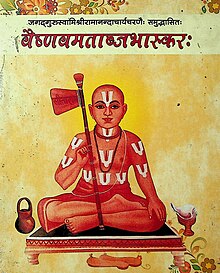| Vaishnava Matabja Bhaskara | |
|---|---|
 Ramananda with his Tridanda | |
| Information | |
| Religion | Hinduism |
| Author | Ramananda |
| Language | Sanskrit |
| Chapters | 10 |
| Verses | 204 |
The Vaishnava Matabja Bhaskara (IAST: Vaiṣṇava Mātābja Bhāskara, Sanskrit: वैष्णवमताब्जभास्कर:) is one of the most prominent works of Ramananda[1] in Sanskrit. This work is a dialogue between Ramananda and his disciple named Surasurananda.
In the Vaishnava Matabja Bhaskara, Ramananda has answered the 10 most prominent questions related to Vaishnavism. Its primary focus is worship of Rama along with Sita and Lakshmana.[2] The text mentions that one's devotion should be like flowing oil which means consistent or unbreakable.[3] According to this text, the ultimate goal of a person is the attainment of Rama as he is one who resides in everyone's heart and is the protector of whole universe and who is known through Upanishads.[4] By practicing under the guidance of a guru, a person reaches the divine abode, Saketa, where one attains the proximity of Sri Rama. From there, one does not return to this earthly realm.[4] The philosophy of Ramcharit Manas is also in accordance to Vaishnava Matabja Bhaskara.[4] The text also states that every individual irrespective of his colour, gender, caste, background etc. is worthy of Sharnagati unto the holy Lotus feet of Rama, Ramananda in his Vaishnava Matabja Bhaskara says:[5]
सर्वे प्रपत्तेरधिकारिणः सदा शक्ता अशक्ता पदयोर्जगत्प्रभोः । अपेक्ष्यते तत्र कुलं बलञ्च नो न चापि कालो न च शुद्धतापि वै ॥ Everyone has the right to seek refuge in Lord Shri Ram, regardless of their capabilities, as the supremely compassionate Lord does not expect the strength of high lineage, knowledge, appropriate timing, or any kind of purification for accepting one at His divine feet. Hence, every individual is entitled to attain the grace of the Divine.—Vaishnava Matabja Bhaskara Chapter 4
- ^ Pandey, Dr. Rajbali (1970). Hindu Dharma Kosha (5th ed.). Lucknow: Uttar Pradesh Hindi Sansthan. p. 612. ISBN 9788193783948.
- ^ Shastri, Koushalendra Das (2010). Kalyan Ank - Jeevancharya Ank (1st ed.). Gita Press Gorakhpur. p. 116.
- ^ Sharma, Munsiram (1958). Bhakti Ka Vikas (1st ed.). Varanasi: Chaukhamba Vidyabhawan Chauk. p. 375.
- ^ a b c Pandey, Rama Niranjan (1960). Rama Bhakti Shakha (1st ed.). Hyderabad: Nava Hindi Publications. p. 50.
- ^ Sharma, Jaykant (2022). Vaishnav Matabja Bhaskara (in Sanskrit). New Delhi: Shri Lal Bahadur Shastri Samskrit University. p. 137. ISBN 978-8187987-901.
© MMXXIII Rich X Search. We shall prevail. All rights reserved. Rich X Search
